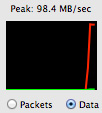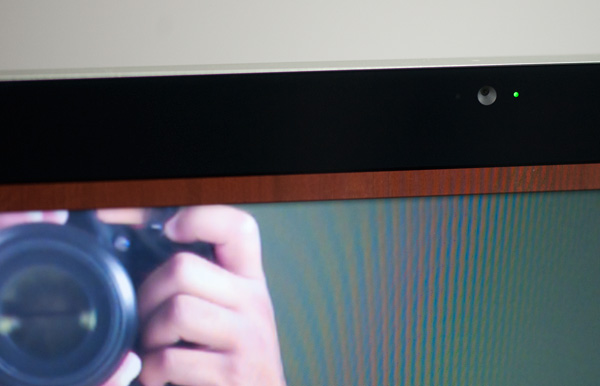The Apple Thunderbolt Display Review
by Anand Lal Shimpi on September 23, 2011 2:56 AM EST- Posted in
- Displays
- Mac
- Apple
- Thunderbolt
- Thunderbolt Display
Testing the Pieces
Before we get to the display and Thunderbolt specific testing I wanted to confirm that the individual controllers in the Thunderbolt Display were just as capable as those in the Mac it was connected to. For the most part, they are.
Following in Brian Klug's footsteps, I created two RAM disks - one on a MacBook Air and one on a MacBook Pro. I connected both systems to my local GigE network and copied giant files between them. I measured over 780Mbps going from the MacBook Air to the MacBook Pro, and 832Mbps in the other direction (images below). That's about as good as it's going to get.
 |
 |
Next I tested performance over FireWire 800 and USB 2.0. For FireWire 800 I used a Western Digital My Book Studio Edition II configured in RAID-1 and measured peak read speed from the device. For USB testing I turned to a Corsair Flash Voyager 3.0 (USB stick) and a SF-2281 SSD connected to a SATA-to-USB bridge. In both of the USB tests I measured write speed to the USB 2.0 devices. Apple appears to have chosen its FireWire controller well as performance was only off by 2MB/s compared to the FW800 port on the 15-inch MacBook Pro. USB 2.0 performance wasn't nearly as good however, I maxed out at 16.4MB/s and saw typical rates closer to 15MB/s:
| Transfer Rate Comparison | |||||
| FireWire 800 | USB 2.0 (stick) | USB 2.0 (SSD) | |||
| Apple Thunderbolt Display | 70.0 MB/s | 14.1 MB/s | 16.4 MB/s | ||
| Apple 15-inch MacBook Pro (2011) | 72.0 MB/s | 21.2 MB/s | 32.2 MB/s | ||
Both the audio controller and FaceTime HD cameras interface via the Thunderbolt Display's internal USB controller. It's likely that one of those devices is forcing the controller to negotiate at a lower speed and thus ultimately limit peak USB 2.0 performance through the display. Note the gap in performance is much smaller if you're looking at transfers to a USB stick vs. an SSD. I happen to have a lot of SSDs around so I tend to use them as glorified USB sticks, I suspect the majority of users won't notice much of a difference due to the lower overall performance of standard USB sticks.
FaceTime HD Camera
Although Photo Booth in Lion captures at 1080 x 720, using iSightcapture I was able to confirm that the sensor in the Thunderbolt Display appears to be able to capture 1280 x 720 natively. Quality is what we'd come to expect from the current generation of FaceTime HD cameras.
I tested the camera both in Photo Booth and in a FaceTime chat with our own Brian Klug. The experience worked fine in both cases.

FaceTime seems to have issues when one party is in a noisy environment but that doesn't appear to have anything to do with the Thunderbolt Display hardware as I duplicated the issue on a MacBook Air as well. If you're curious, the problem I'm talking about occurs when the party in a quiet environment is trying to talk to the person with a lot of background noise. The quiet party will hear audio just fine but the noisy party will get a lot of broken up audio from the other side. It seems like FaceTime is trying to do some active noise cancelation that ends up doing more harm than good. I confirmed it's a FaceTime software problem by calling Brian via Skype without any issues.











275 Comments
View All Comments
mczak - Friday, September 23, 2011 - link
I'm wondering what the performance would be like? Looks to me like you'd get a far bigger performance hit in this case.Constructor - Friday, September 23, 2011 - link
That would be very interesting indeed.In a discussion over at ars I've been speculating about some of the possible complications with that setup:
http://arstechnica.com/civis/viewtopic.php?t=11558...
(Same user name there.)
Anand, it would be very interesting if you could find out more about the inner workings and the performance consequences of such a combination, possibly confirming or disproving my speculation on the matter.
Over at Macworld they even seem to have made a Cinema display work when plugged in to a Pegasus RAID daisy-chained to a Thunderbolt display. The implications of that and the potential impact on Thunderbolt throughput would be most interesting as well... ;-)
AlexCheng - Friday, September 23, 2011 - link
Sorry guys, but maybe I didn't quite catch it; what exactly is it using as its power supply source? Because it said that the MagSafe port could charge your MacBooks, then where the hell is the cable for its power??Constructor - Friday, September 23, 2011 - link
The display has an ordinary power cable which you'll need to plug into a wall outlet. And the display then powers and charges the MacBok Air/Pro.ltcommanderdata - Friday, September 23, 2011 - link
If Apple goes through with removing the optical drive for the MacBook Pro, hopefully they'll add an optical drive to the Thunderbolt Display. That would make the Thunderbolt Display very complete as a dock.dBoze - Friday, September 23, 2011 - link
Anand,When you mention there is "no analog audio out", I think the inclusion of even analog audio would be a bit of a slap in the face. All Macs in recent history include digital audio through the 1/8" jack via 1/8" TOSLINK, Us Mac users are far too cool for analog ;).
Another solution for digital audio without an extra cable to your MacBook would be using AirPort Express. This will give you a digital or audio connection to your speakers over the network, and you can even plug it into your network via ethernet if your wireless signal isn't too strong. If I recall correctly, you can choose your AirPort Express as the "device for sound output" under the "Output" tab in "Sound" under sys preferences. Of course, you're limited to using AirPlay-compatible applications (iTunes) on the Windows side of things.
Constructor - Friday, September 23, 2011 - link
All recent Macs have both analog (electrical) and digital (optical) audio ports in the same socket. Analog is for convenience, digital is for avoidance of ground loops and of analog signal degradation.An additional audio port (USB/FireWire/Thunderbolt) is possible, if inconvenient.
stanwood - Friday, September 23, 2011 - link
Nice review!A lot of comments about how Apple could have built this display is a way that made it more easily upgradable. This is a PC mentality (which I share). Apple rejects it. Don't waste your time asking for it. If you must have some Mac love, use these 3 simple rules:
1) Buy all your Apple gear in a single release cycle.
1a) Go ahead and upgrade the OS. Those are actually pretty cheap.
2) Use it until you hate it or can't resist getting the new shiny stuff.
3) Give it all to your grandfather, aunt, or Goodwill and return to step 1.
By the time you get to step 3 Apple will have replaced all the important I/Os. There will be no point in trying to upgrade.
mcnabney - Friday, September 23, 2011 - link
Large, high quality displays are expensive, but last a long time. The iMac and displays like this compell people to discard those expensive displays far ahead of their time and likely buy another display of the same size and resolution.My 27" display is on its third computer and it provides better color accuracy than this expensive new one. That is probably my biggest beef with Apple, sending so many nice IPS displays into the trash/closet long before they wear out or become outdated.
slashbinslashbash - Friday, September 23, 2011 - link
Not any more. Starting with the 2010 27" iMac, there was a DisplayPort which was both an input and an output. Now with all the 2011 iMacs having Thunderbolt, they can all be used as displays for other computers with Thunderbolt display output.